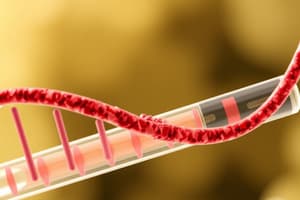Podcast
Questions and Answers
What is needed to avoid self-ligation in vector-vector ligation?
What is needed to avoid self-ligation in vector-vector ligation?
- Use of two blunt-ended enzymes
- Use of two sticky-ended enzymes
- Incompatible vector ends
- Compatible vector ends (correct)
In the context of DNA modifying enzymes, what is the purpose of using two enzymes with incompatible sticky ends?
In the context of DNA modifying enzymes, what is the purpose of using two enzymes with incompatible sticky ends?
- To prevent ligation
- To achieve directional ligation (correct)
- To enhance DNA replication
- To promote self-ligation
Which enzyme is used to chew away the single-stranded overhangs of DNA in a 3’ to 5’ direction?
Which enzyme is used to chew away the single-stranded overhangs of DNA in a 3’ to 5’ direction?
- Alkaline Phosphatase (correct)
- Ligase enzyme
- HindIII
- BamHI
What type of reaction is used to polish the overhangs of DNA?
What type of reaction is used to polish the overhangs of DNA?
What is the purpose of using linkers in DNA modifying procedures?
What is the purpose of using linkers in DNA modifying procedures?
Which component is necessary for a ligation reaction to be successful?
Which component is necessary for a ligation reaction to be successful?
What enzymatic action is involved in making DNA ends compatible during the chew-in reaction?
What enzymatic action is involved in making DNA ends compatible during the chew-in reaction?
Why are two enzymes, one blunt and one sticky, used together in some DNA modifying processes?
Why are two enzymes, one blunt and one sticky, used together in some DNA modifying processes?
What is the importance of using ligase enzyme in a ligation reaction?
What is the importance of using ligase enzyme in a ligation reaction?
Flashcards are hidden until you start studying




